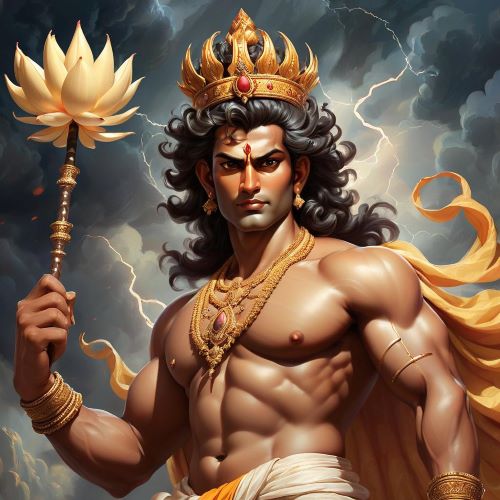Surya : The Sun God
Listen
At a glance
| Description | |
|---|---|
| Origin | Indian Mythology |
| Classification | Gods |
| Family Members | Kashyapa |
| Region | India |
| Associated With | Sun, Morning |
Surya
Introduction
Surya, the Sun God in Hindu mythology, plays a crucial role as the harbinger of light and life. Known also as Aditya, Surya is revered for his role in creating and sustaining the universe, symbolizing not just the physical sun but also spiritual enlightenment and cosmic order. His chariot, drawn by seven horses and steered by Aruna, personifying Dawn, travels across the sky daily, bringing light and warmth to the world..
Physical Traits
Surya, depicted as a radiant deity, embodies divine light with a complexion resembling the hues of sunrise and sunset—golden or crimson. Adorned in ornate jewelry made from precious gems, including a crown, earrings, and necklaces, Surya is portrayed with four arms holding a lotus, conch shell, discus, and mace.
Central to his iconography is his role as the charioteer of a magnificent golden chariot drawn by seven celestial horses, symbolizing the colors of the rainbow and days of the week. The chariot itself is adorned with celestial beings and intricate carvings. This depiction symbolizes Surya’s journey across the heavens, radiating energy and vitality essential for life.
Family
Surya, the Sun god in Hindu mythology, boasts an illustrious lineage. Born to Sage Kashyapa and Aditi, he counts among his siblings deities like Indra, Agni, and Vishnu. His wife, Sanjna, unable to bear his radiant intensity, created a shadow form named Chhaya to manage their domestic responsibilities. Surya’s progeny include significant figures such as Manu, the progenitor of mankind, Yama, the lord of death, and the divine physicians, the Ashvins. Notably, Karna, the tragic hero of the Mahabharata, is also attributed as Surya’s son. This diverse family underscores Surya’s pivotal role as a cosmic progenitor influencing various facets of human existence.
Other names
Surya, the Sun god of Hindu mythology, is revered across diverse cultures under various epithets that highlight different aspects of his luminous and cosmic presence. Known as Aditya, he stands as the chief among the Adityas, a group of solar deities symbolizing divine leadership. The name Arka underscores his radiant brilliance, while Bhanu emphasizes his role as the shining bringer of light to the world. As Savitr, Surya is revered for his creative and life-giving energies, inspiring and energizing all life forms. Pushan portrays him as a benevolent protector of cattle and travelers, ensuring their safety on their journeys. Ravi, a simple yet profound name meaning “sun,” encapsulates his essential nature as the radiant center of our solar system.
In ancient Indian literature and mythology, Surya is also known by other significant names such as Martanda, Mitra, Bhaskara, Prabhakara, Kathiravan, and Vivasvan, each adding layers to his mythological persona. These epithets collectively illustrate Surya’s multifaceted symbolism and enduring importance, weaving through the cultural fabric of ancient traditions and spiritual beliefs centered around the life-giving power of the sun.
Powers and Abilities
Surya’s divine powers encompass a wide array of cosmic abilities. As the source of light and warmth, he not only sustains life but also symbolizes the triumph of knowledge over ignorance by dispelling darkness. Revered for his healing rays, believed to cure ailments and rejuvenate both body and mind, Surya embodies vitality and energy essential to all living beings. His chariot, drawn by seven celestial horses, signifies his swift journey across the sky, regulating time and seasons. In Hindu astrology, Surya holds significant sway as the lord of Simha (Leo), embodying immense power and cosmic influence. The Gayatri Mantra, invoking his blessings with “Oṃ Adityayah Namo Namaḥ” and “Oṃ Surya Devāya Namaḥ,” underscores his role as the ultimate source of energy and vitality in the universe.
Modern Day Influence
Surya remains a beloved figure in contemporary times, celebrated through various religious rituals and architectural marvels like the Konark Sun Temple in Odisha, India, dedicated to his glory. The practice of Surya Namaskar (sun salutation) in yoga and meditation pays homage to his life-giving energy, promoting physical health and mental clarity. Across India, Surya worship thrives with numerous temples dedicated to him, emphasizing his enduring cultural significance.
Beyond religious devotion, Surya’s influence extends into modern practices and beliefs. The adoption of solar energy as a clean and renewable power source reflects the ongoing relevance of Surya’s energy in today’s world. Symbolizing light, knowledge, and spiritual enlightenment, Surya inspires artists, poets, and philosophers, serving as a symbol for the pursuit of truth and the illumination of the human spirit. Festivals and pilgrimages dedicated to Surya, such as Makar Sankranti, Pongal, and Ratha Saptami, further underscore his widespread influence across different Indian states and communities.
Related Images
Frequently Asked Questions
What is lorem Ipsum?
I am text block. Click edit button to change this text. Lorem ipsum dolor sit amet, consectetur adipiscing elit. Ut elit tellus, luctus nec ullamcorper mattis, pulvinar dapibus leo.
What is lorem Ipsum?
I am text block. Click edit button to change this text. Lorem ipsum dolor sit amet, consectetur adipiscing elit. Ut elit tellus, luctus nec ullamcorper mattis, pulvinar dapibus leo.
What is lorem Ipsum?
I am text block. Click edit button to change this text. Lorem ipsum dolor sit amet, consectetur adipiscing elit. Ut elit tellus, luctus nec ullamcorper mattis, pulvinar dapibus leo.
What is lorem Ipsum?
I am text block. Click edit button to change this text. Lorem ipsum dolor sit amet, consectetur adipiscing elit. Ut elit tellus, luctus nec ullamcorper mattis, pulvinar dapibus leo.
What is lorem Ipsum?
I am text block. Click edit button to change this text. Lorem ipsum dolor sit amet, consectetur adipiscing elit. Ut elit tellus, luctus nec ullamcorper mattis, pulvinar dapibus leo.












